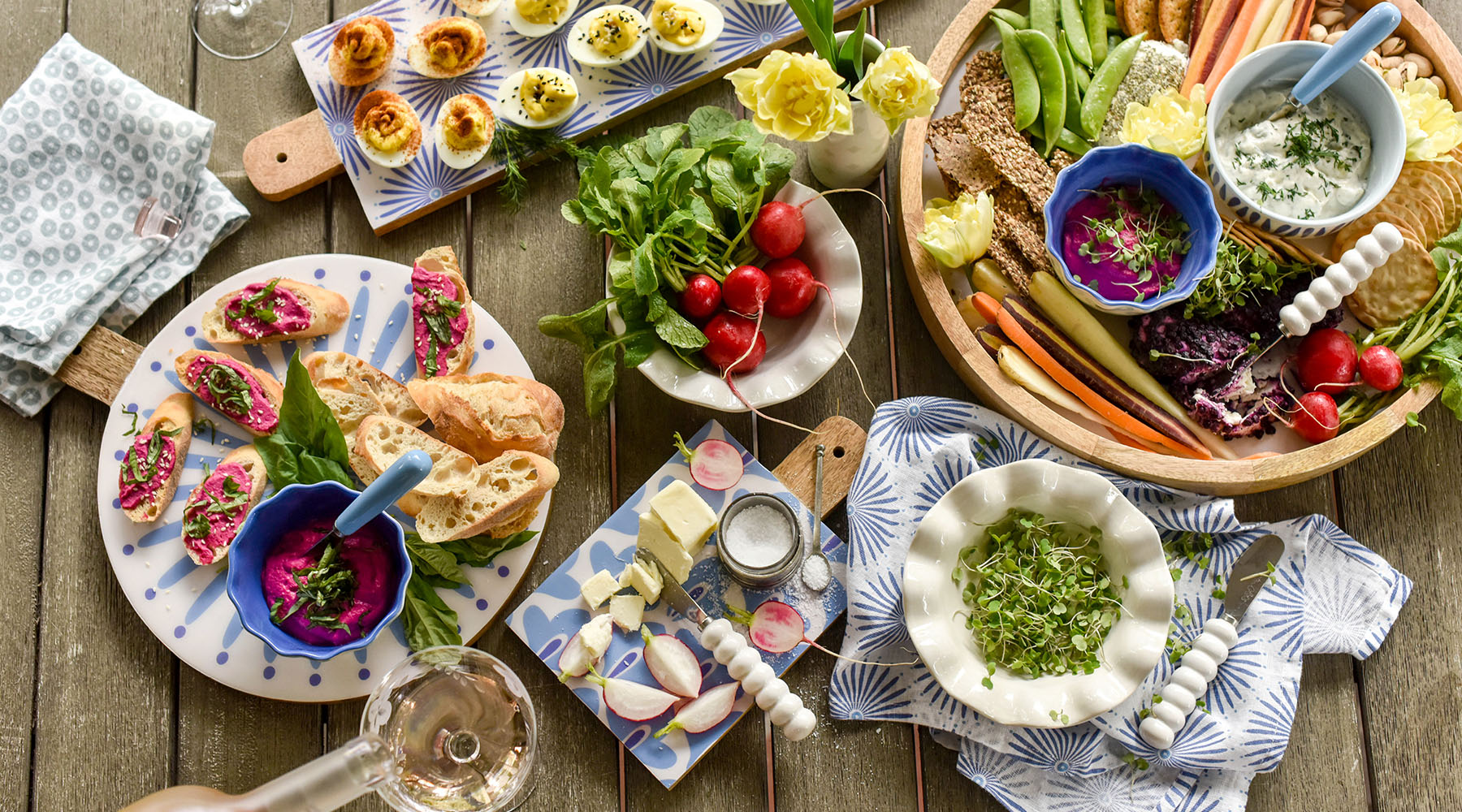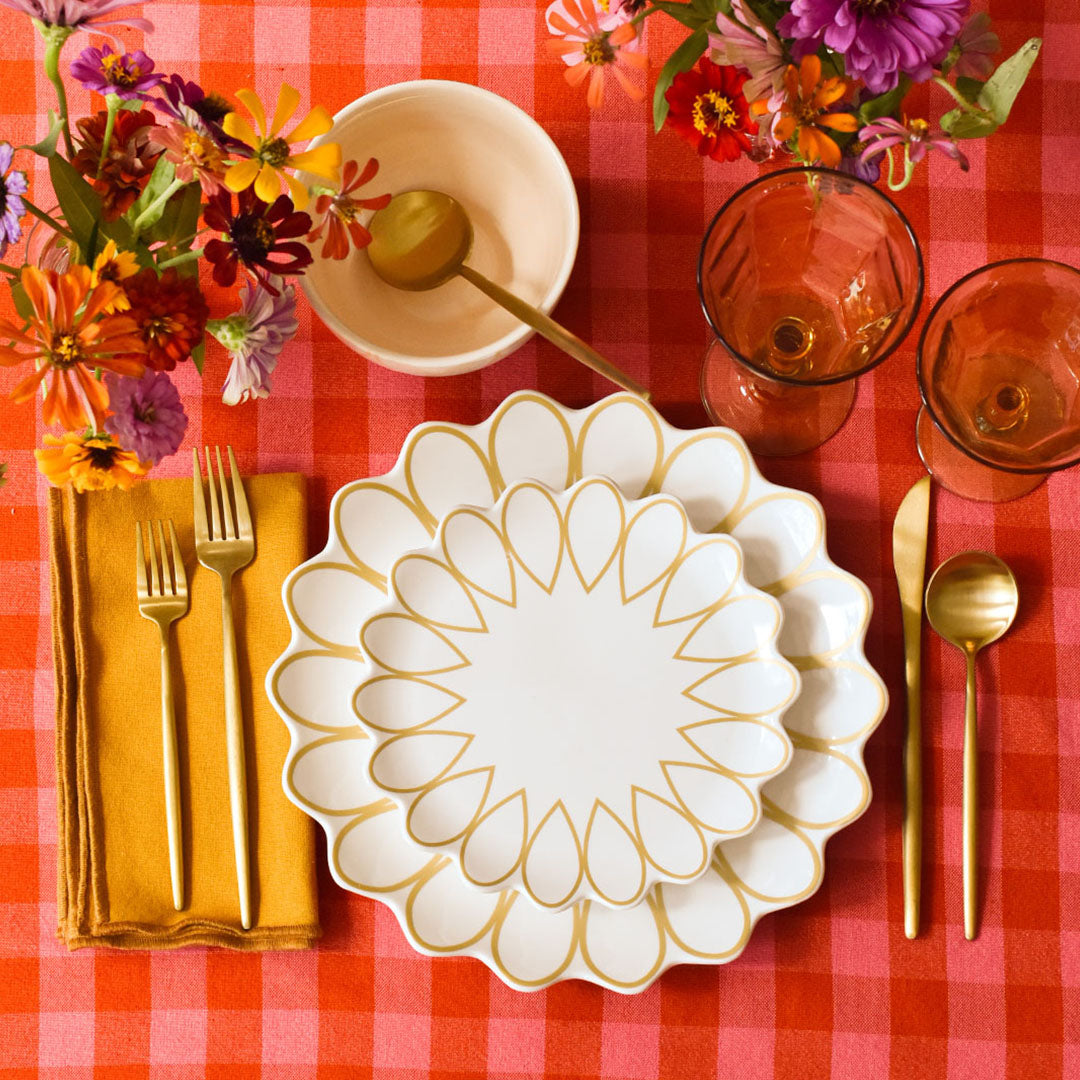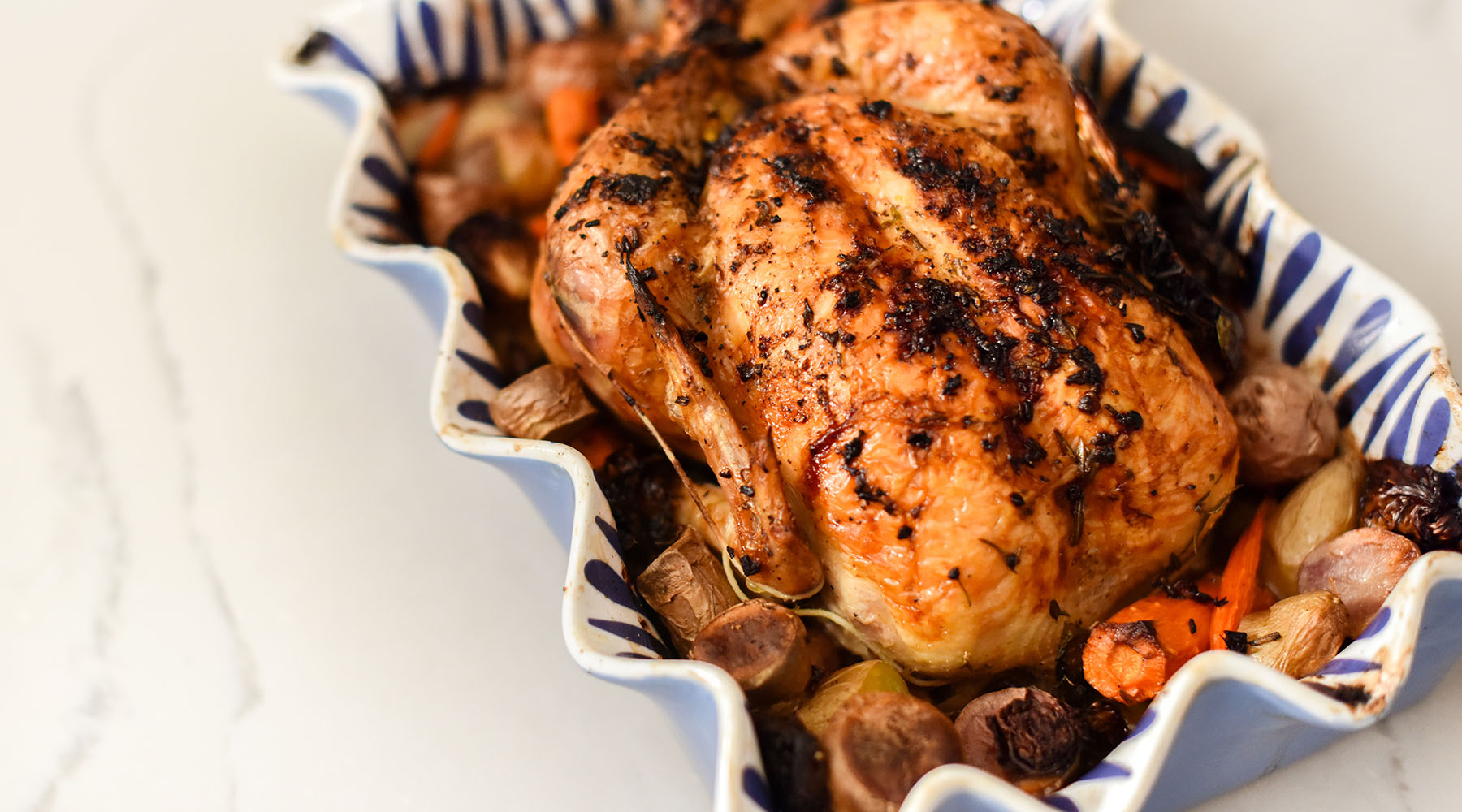
How to Host a Charcuterie Party for Any Occasion
While small, delectable bites are traditionally reserved as pre-dinner appetizers or mid-day snacks, that doesn't always have to be the case. Indulge in all your favorites on a large scale and all at once by hosting a charcuterie party. Whether you enjoy a garlicky Boursin, a peppery salami, or perfectly ripe strawberries you can mix-and-match your favorites to create your perfect charcuterie board.
Charcuterie parties allow people to gather together, share delicious food, and appreciate the artistry and craftsmanship of a creative {and tasty} board of meats, cheeses, and more. And you're in luck— anyone can plan a party with charcuterie wood boards.
Whether you're looking for a crowd-pleasing menu for a movie marathon with friends or are trying to dress up your favorite foods for a formal cocktail party, one thing is certain: there's something for everyone on a charcuterie serving board. All it takes is a little menu selection, the right serveware essentials, and a creative and open mind.
What Does Charcuterie Mean?
The term charcuterie originated from French cuisine and originally referred to cured meats; but nowadays, it means something more. Charcuterie wood boards have evolved into a modern culinary staple in households worldwide, typically depicted as an array of meats, cheeses, produce, nuts, and more. Whether you've seen the lavish and colorful charcuterie serving boards in TikTok trends or grew up enjoying these classic meat and cheese bites on wood serving boards, one thing is certain: charcuterie is here to stay.
Why We Love Charcuterie Wood Boards
As artists, we love any chance to get creative and express ourselves, especially when hosting. Charcuterie is versatile, allowing us to show off our favorite wood serving boards while assembling a gorgeous variety of finger foods. You can tailor the menu selection to suit a wide variety of different tastes and dietary preferences, which is our favorite way to utilize them for parties.
Ultimately, we love charcuterie because it brings people together, sparking conversations and fostering connections over small and delicious bites. Easy to eat and perfectly convenient, charcuterie wood boards make the best backdrop for meaningful interactions and lasting memories between friends and family, no matter the occasion. Wood serving boards are the perfect way to cater to any kind of event, effortlessly adapting to any occasion, from intimate gatherings to grand parties.
The 5 Ways to Prepare a Wood Charcuterie Board
The key to hosting a fun and exciting charcuterie party is learning how to get creative with your charcuterie wood boards. These are five beloved options for serving your guests all your favorite bites:
- Traditional: typically served on a charcuterie wood board, charcuterie refers to meat. Cheeses and breads are there to complement flavors but are a secondary addition.
- Cocktail garnish: features specialty ingredients, like celery or olives, to customize any alcoholic drinks {or mocktails} being served.
- Grazing board: think of this wood serving board style as a larger-scale twist on traditional, adding many accouterments like eggs, nuts, honey, and more to keep your guests full.
- Crudités board: this charcuterie wood board variation offers mainly vegetables and fruits, with the occasional tasty dip or glaze.
- Not-quite-charcuterie: we won't quite call them charcuterie serving boards — but they do work for charcuterie parties as not-so-typical twists on a traditional charcuterie board. Think of things like assortments of baked goods, candies, or even butter boards.
What is a Charcuterie Party?
While charcuterie wood boards are traditionally served as an appetizer or hors d'oeuvre option, at a charcuterie party, they are the main event. Similar to a tapas party or tasting menu, there's something fun and intimate about getting to fill up on small bites throughout a gathering. With customizable options that can suit anyone's tastes, planning large-scale charcuterie serving boards and extravagant spreads adds a special, personal touch to any event.
Perfect Occasions for Charcuterie Parties
There's never a wrong time to load up a charcuterie wood board with all your favorite treats. The very sight of one traditionally sets up a relaxed atmosphere where guests can mingle, snack, and indulge. From casual yet elevated gatherings to even more formal affairs, ranging from intimate get-togethers with your closest friends to larger events such as corporate functions, charcuterie wood boards bring people together—and keep them full. Some of our favorite occasions include:
- Movie nights
- Intimate dates
- Girls' nights
- Cocktail parties
- Casual game nights
- Engagement celebrations
- Baby showers
5 Steps to Hosting a Charcuterie Board Party
It doesn't matter if you're new to hosting or you've been doing it for tens of years— anyone can host a charcuterie party. All it takes is a little planning, delicious ingredients, and the right wood serving boards. Follow these five simple steps to get started:
Step 1: Consider a Theme
While not all charcuterie wood boards need a theme, we can't help but consider theming all of our gatherings. Having a theme can create a focused approach to your decision-making. Helping you make quicker decisions for menu, cocktails, tablescape, and more. Basing the details of an event on a specific theme can help make planning events easier, and we’re all for that. Most people can wrap their heads around theming a plated meal: the same rules apply to a charcuterie serving board.
As you plan your gathering, let the potential theme inspire your wood serving board. Everything, from ingredients to colors to textures and more, on a charcuterie wood board can help solidify the theme and make your party memorable.
Charcuterie Serving Board Theme Ideas
From Halloween charcuterie wood boards to seasonal produce and more, there are countless theme ideas to explore. These are a few of our favorites:
By Color: Challenge your guests to create a charcuterie serving board using a specific color palette.
Regional Flavors: Focus on a specific region or country's charcuterie specialties, such as Italian, Spanish, or American. Italy has some wonderful cheese options, as detailed by Marcie in the blog post "2 Weeks in Tuscany."
Seasonal: Highlight seasonal ingredients and flavors, such as a summer-themed party with fresh fruits and lighter meats or a winter-themed party with hearty meats and cheeses. Use Brightland's produce calendar to find the best seasonal veggies and other foods to feature on your charcuterie wood board.
Farm-to-Table: Emphasize locally sourced and artisanal products, showcasing the best offerings from your local farmers market.
Gourmet vs. Comfort: Explore the contrast between gourmet and comfort charcuterie, offering a mix of upscale and familiar meats, cheeses, and accompaniments.
Classic: Pair different types of charcuteries with complementary wines or other beverages, focusing on the art of flavor pairing.
Brunch: Offer a brunch-themed charcuterie serving board with breakfast meats, pastries, fresh fruits, and gourmet spreads that are perfect for weekend gatherings. Think goat cheese, cream cheese, brie, seasonal fruits, etc.
Step 2: Put Together the Charcuterie Menu
When selecting ingredients for your charcuterie serving board menu, focus on including a variety of interesting flavors, textures, and colors. One simple way to ensure that your charcuterie serving boards include a little bit of everything is to follow the 3-3-3-3 rule: every board should have three meats, three cheeses, three starches, and three accompaniments, like fresh produce, dried fruits, or nuts.
Pro tip: Consider your guests' different food allergies/preferences so everyone can eat something off the board. If a guest does have a food allergy, make sure to not include it on a board with items that the guest usually enjoys {to avoid cross-contamination as best as possible}.
Step 3: Decide on the Size and Number of Charcuterie Serving Boards
After determining your guest list, the next step is to figure out portions and sizing. The number of attendees at your party will directly affect how much charcuterie you need and how many charcuterie serving boards, platters, and bowls are necessary to keep everyone fed.
If you're hosting an intimate gathering, you will likely only need one or two wood serving boards. These can either be set in your main dining area for the event or be brought around the room by hired hands in a traditional hors d'oeuvres style. Make sure to keep extras of the popular ingredients on hand in case you need to refill your charcuterie wood board throughout the night.
Consider going larger-than-life with a sprawling grazing charcuterie serving board for extra-large gatherings, such as wedding celebrations or graduation parties. Choose a long serving space, set up your table linens, and place multiple wood serving boards in a cluster. Fill each one to the brim {almost overflowing} with your charcuterie menu. With this style, guests can fill their plates with foods that tickle their fancy and continue mingling.
Step 4: Choose Your Wood Serving Boards and Serveware
Before your build your board you have to choose the best charcuterie serveware for your party. While a classic wood serving board complements any décor, we love to use a patterned charcuterie serving board to tie the tablescape and theme together. Try assembling your charcuterie on a citrus mango wood serving board for a summer soiree or a serene Iris Blue sqaure platter as the "something blue" in a bridal shower — the options are endless.
Platters and boards aren't the only essential: don't forget to choose a few charcuterie bowls. These small bowls can help break up the monotony on a plate, add dimension, and separate certain foods and accompaniments, such as nuts, chocolate, and more. Charcuterie bowls are especially essential if you're offering any dips or jams.
Pro tip: make sure to stock up on small appetizer utensils for any spreadable cheese or dips. Keep these next to their coordinating charcuterie bowls and plates so guests can easily serve themselves.
Why Does Wood Work Best for Charcuterie Boards?
When it comes to choosing serveware, we always recommend a wood serving board. Wood is the preferred {and best} material to serve charcuterie due to its durability and antibacterial properties—and, of course, how easy it is to clean. At Coton Colors, we use mango wood and acacia wood in our wood serving boards and platters.
In terms of setting the table, wood serving boards can also pair with just about anything, adding a rustic look to any tablescape. Our mango wood serving boards use sustainably harvested wood from trees that no longer produce fruit, giving us a sturdy and attractive base for our enameled, patterned surfaces. When we aren't using a traditional charcuterie serving board, we love layering our one-of-a-kind ruffled acacia wood plates in with other signature collections for a natural pop of texture.
Essential Serving Utensils for Charcuterie Serving Boards:
Keep these helpful utensils near your wood serving board at the party
- Tongs
- Serving sets
- Toothpick holders
- Appetizer forks
- Appetizer spoons
- Appetizer knives
Step 5: Assemble Your Charcuterie Wood Board
Cutting, folding, and assembling the food to have a variety of textures is key to a visually pleasing wood serving board. Half the appeal of a charcuterie serving board is "eating with your eyes first," especially when charcuterie is the main attraction for your party.

Don't just set your ingredients down willy-nilly. The best way to create a memorable charcuterie serving board is to focus on adding visual interest, as seen in some of our favorite methods:
- Fold and twirl your deli meats into fun shapes, such as rippling lines down the wood serving board or a salami rose.
- Use small bowls to break up your board and add varying heights.
- Cut things like vegetables and fruits lengthwise to allow for easy dipping and layering.
- Use a fun cookie cutter to create unique shapes out of cheese and meat {especially if your children need encouragement to dig in}.
- If you have specific pairings, place those ingredients near each other to encourage guests to try them together.
When to Make and Put a Charcuterie Serving Board Out
If you're trying to fit assembling the charcuterie wood board into your party prep timeline, we recommend putting together your board about 30 minutes before guests arrive. If you must do it earlier, prepare the wood serving board within 12 hours and just pop it in the fridge, taking it out about an hour so before your loved ones come over.
How to Clean a Charcuterie Serving Board After Use
After the party dies down, cleanup for charcuterie wood boards is easy. For all-wood serving boards, careful washing and drying is the secret to ensuring they last for years to come. After washing, treat your wood serving boards with natural, food-safe oil to keep your product moisturized and ready for all of life's many celebrations. For our mango wood enamel boards, you can simply wipe clean with a damp cloth.
Whether you consider yourself an expert at wine and cheese pairings or are looking for a crowd-pleasing way to serve all your loved ones at once, charcuterie parties are perfect. With the right guidance, the perfect charcuterie wood board, and a little creativity, anyone can host a charcuterie party.



















Leave a comment
This site is protected by hCaptcha and the hCaptcha Privacy Policy and Terms of Service apply.